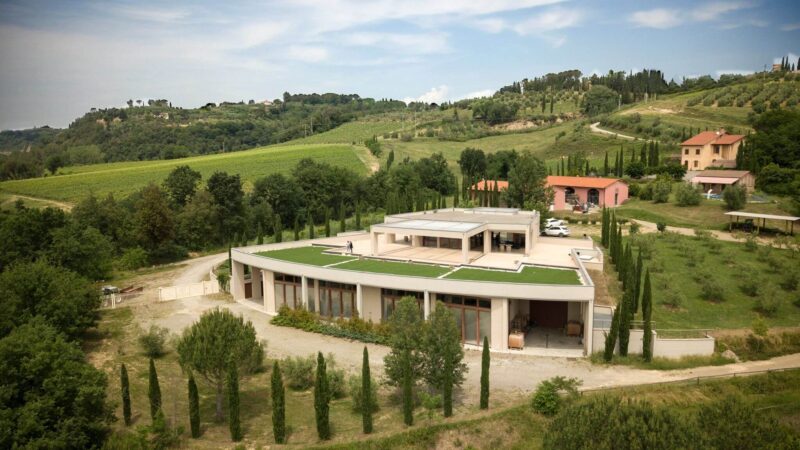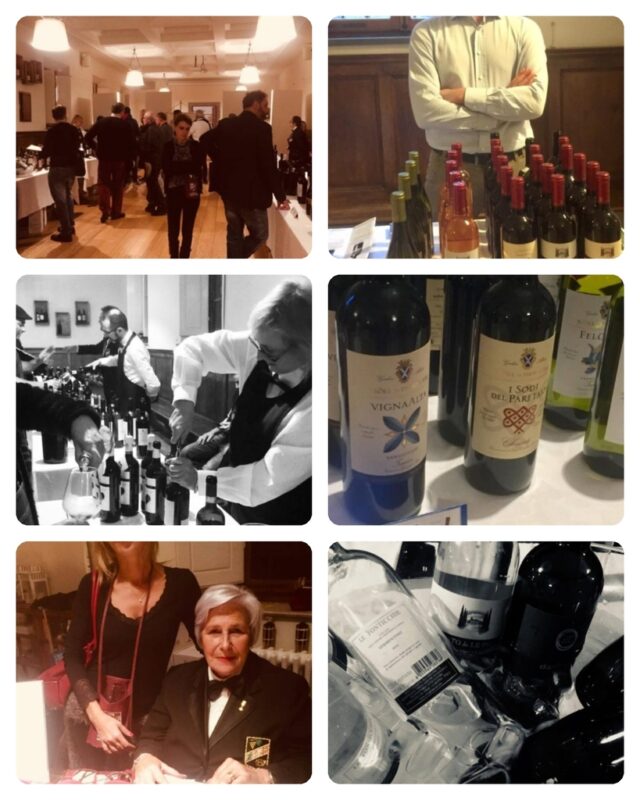“ The most important thing is not what you find at the end of a race, but what you feel inside while running”
“Arrighi Winery”, Porto Azzurro. Elba
At the end of the month of July , I visited “Arrighi Winery” . Meanwhile, I had the possibility to discover all the beauty of Elba , which is the largest island of the seven jewels of the “Tuscan archipelago”. According to a legend, losing her necklace in the Tyrrhenian sea, Venus created the “Tuscan archipelago” , which also consists of :
Yes of course, rolling hillsides, sunflowers, cypresses and beautiful towns, but there’s much more in Tuscany, like Elba, a slice of paradise. This amazing Tuscan island is destined to be turned into one of the coolest destinations of Italy . Why? Becasue of f its terrific beach-laced coves, vineyards, azure waters, mind-bending views, and more over!
“Arrighi Winery” a way to discover Elba
Elba is probably most famous due to being the place, which Napoleon choose for his exile in 1814–15 after his defeat at Waterloo. Not a bad place to be banished I have to say! As a result of being elected “Emperor of Elba” in 1814 , he left a significant mark of his short reign. Whta? In particular , these magnificent noble residences in Portoferraio, which is the main city of the island:
Elba is located 6.2 miles from the coastal town of Piombino, and, with an area of 86 square miles (223 square km), it’s an unspoilt pearl of Tuscany: clear blue sea, sandy beaches, wonderful landscapes, and mild climate. There is a varied vegetation of Mediterranean type, which is rich in olive groves and vineyards.
Elba is not a typical tourist destination
Being a spot off the beaten path , Elba is not a typical tourist destination, Elba is infact mostly frequented by Tuscany residents. You’ll not find hordes of people or lines and crowds like in other Mediterranean islands, such as in Sicily or in Sardinia. So, if you want to avoid them too, book a trip in spring or early autumn !
Moreover, Elba is a land full of history: remains of the Etruscan, Roman and Medieval ages testify a fascinating past and rich wine cultural heritage .
Above all, Elba is well worth being seen for the flavours of its cuisine too, which is made from simple dishes and fantasy. Being an island, Elba has several fish restaurants. Every morning, fishermen go offshore and fish all day. Lovely, in the late afternoon, they bring their catch to the island’ s restaurants.
If you haven’t visited Elba yet, you need to . Right now! This gorgeous small island is destined to be turned into one of your must-see places !
Elba History
Being inhabited since pre-historic times, Elba was discovered early on to be ripe with iron-ore deposits. Elba attracted a lot of ancient people, such as the Etruscans and the Greeks. They called it “Aethalia” (which means “smoky place”, probably because of the smelting furnaces). Later the Romans, renamed it “Ilva”, established a naval base on the island.
Over the centuries Elba underwent many other invasions and dominations. In the early Middle Ages, Elba was ruled by Pisa, in 1290 by Genoa, in 1399 by the “Dukes of Piombino”, and in 1548 by Cosimo I de Medici of Florence. From 1596 until 1709 the Eastern part of Elba was under the Spanish Empire control for about 150 years, then the whole territory was conquered first by Naples, and finally by the French in 1802.
When Napoleon I abdicated in 1814, he was exiled to Elba, where he landed on May 4. Since then, Elba was recognized as an independent principality with Napoleon as its jing until February 26, 1815. Thereafter, Elba was restored to Tuscan, with which it passed to unified Italy in 1860.
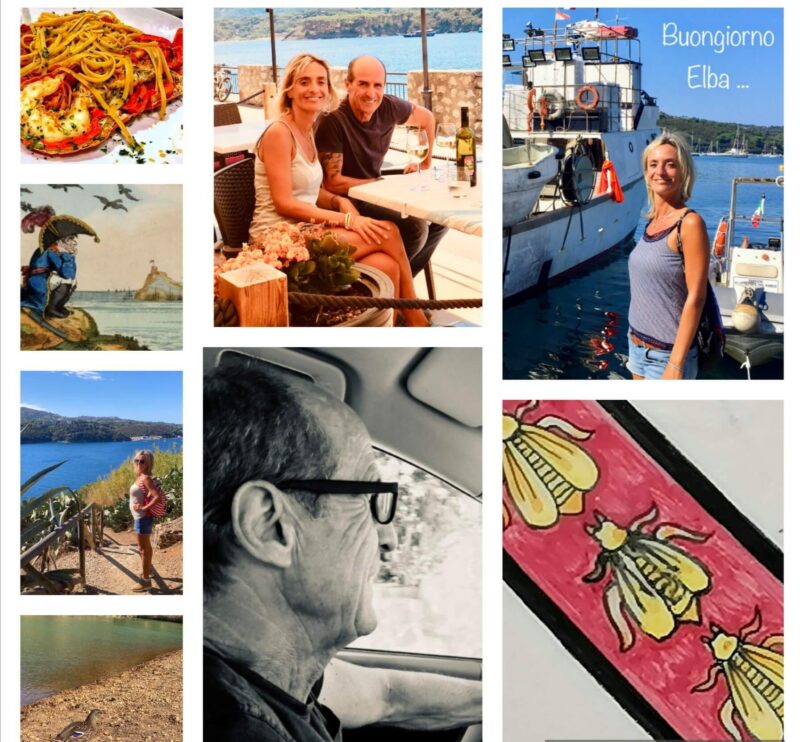
1st day , 23th July. Arrival in Portoferraio
Elba, is surprisingly easy to reach as well! I took a train from Pisa to Piombino Marittima . Then from the station I had a short walk to the ferry reaching Elba in 45 minutes!
Approaching Elba, I was amazed at how massive and densely forested it was. After disembarking in pastel-hued Portoferrario, Elba’s largest city founded by Cosimo I de’ Medici in 1548, I headed down the red pedestrian pathway towards the town with a tour of Napoleon’s Residences above mentioned.
I took lots of photos strolling around the cobbled streets of the cute Portoferrario, both in the city center and in the old town. I kept walking taking a hike to the “De Medici fortress” , a great example of a defensive military architecture of the XVI century.
Grand Duke of Tuscany Cosimo l built this big complex of fortified walls and old forts (“Fort Falcone” , “Fort Stella” and“Linguella Tower”) as a defence against the Turkish attacks. Without any doubt from there I enjoyed breath taking panoramic views.
Porto Azzurro is waiting for me!
Then as the day was really sultry, I had to rest, drinking a cold cola in one of the many beach cafes which dotted the little port . My cola ice cubes turned into water fort the summer heat, while I was waiting in Portoferrario for Antonio Arrighi. This multitalented wine entrepreneur welcomed me at his winery in Elba for an interview . Antonio picked me up at the bar and drove me to Porto Azzurro, a tiny fisher village where he lives and works.
Porto Azzurro is the second most important inhabited center of the island . It was a fortune to spent three days in this quaint village, staying at the central “Belmare Hotel” . After I unpacked my bags , Antonio and me had our lunch at “Sopravento restaurant” to speak about the interview.
First my attention was captured by our succulent seafood dishes:
- “Scialatelli” : a type of thick and short fettuccine or linguine-like pasta made in Campania, with lobsters;
- A wide range of starters and crudités paired with his fruity white wine “Eraora”, made from Chardonnay and Incrocio Manzoni (Riesling and Pinot Blanc) grapes.
During our delicious lunch , Antonio started to talk about his life, while I was listening carefully. That’s all, time went by faster and faster . Yes, I can say that I was totally enchanted by his words, being completely absorbed in his speech!
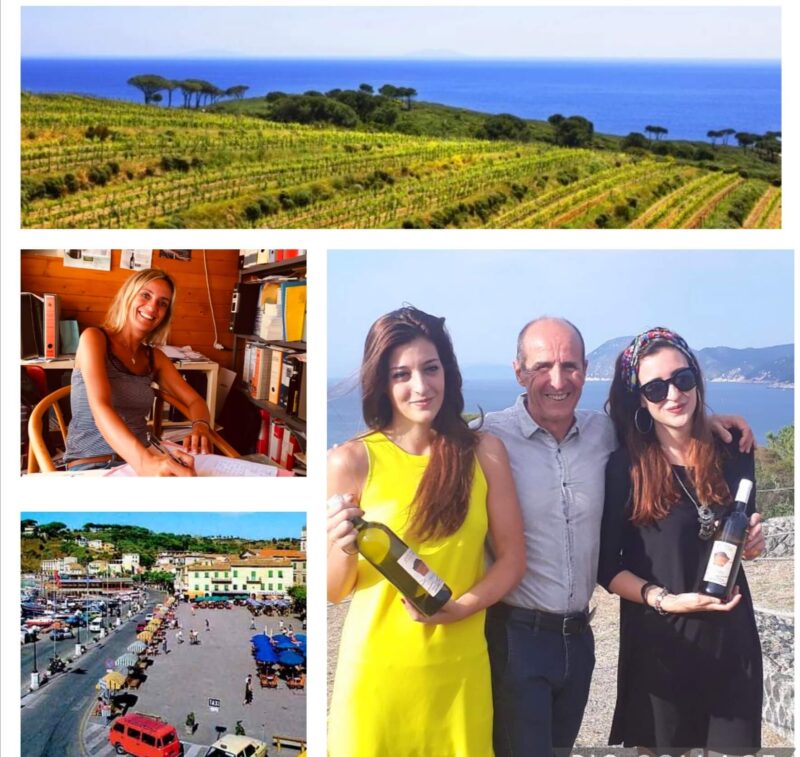
Antonio Arrighi , the famous winemaker of Elba island
What about Antonio Arrighi ? Well, he was born in the room number 13 of “Belmare Hotel” (where I was hosted, what an happy coincidence!) in Porto Azzurro. Once this hotel belonged to his father, therefore Antonio was raised in a family of experienced hoteliers and restaurateurs with a long tradition of hospitality in Elba.
In 1960, when tourism was booming in Elba, the Arrighi Family started the hotel business, and in 1970 run a farm for its hotel clients producing different types of meat (pork, rabbit, etc), flowers, peaches and grapes. As a child Antonio was always involved behind the scenes.
In 1980 Antonio became a sommelier (he is still being part of the Elba Delegation of “AIS Toscana”), not only to take care of his vineyards, but also for making excellent wine!
In 1995 a great opportunity knocked on his door , when Antonio undertook an ambitious project in collaboration with the Tuscan Region and with Paolo Storchi (senior researcher at CREA (“Council for Agricultural Research and Agricultural of Arezzo”).
The ambitious idea of Antonio was about understanding which international grape varieties along with the local ones could grow in Elba. He found the answer in these grapes:
- Syrah, Sagrantino and Tempranillo for the red wines, ;
- Incrocio Manzoni, Chardonnay , and Viognier for the white ones.
Antonio went on with planting these selected international grape varieties in Elba, being drought and diseases resistant. Moreover, these international grape varieties complied with high quality standards and delivered consistent results time after time.
Antonio Arrighi’ s family
Since 2000 onwards Antonio was fully dedicated to his winemaking passion, which turned into his main activity. His family is very supportive . Each of them helps Antonio with the wine business: Giulia is the young oenologist, Ilaria deals with the marketing, and the little Matteo is still growing up!
Piazza Matteotti in Porto Azzurro, Elba
After my fantastic lunch with Antonio , I went back to my hotel to sleep a little bit. Late in the evening after my little nap, I wandered through the narrow streets of Porto Azzurro:
- Along “Via Solferino”, “Via dei Martiri” and “Via XXV Aprile”, till to “Piazza Matteotti”, which is main square of Porto Azzurro. It is magnificent meeting point for the locals and the heart of social life in Elba too!
From “Piazza Matteotti” I continued down the main streets of the harbour:
- “Via Vitaliani” and “Banchina 4 Novembre” , which were coloured by the balcony flower pots, by the souvenirs shops and by the moon which had risen over the harbour.
While I was relaxing with a wonderful “apericena” in the nice “Bar Corinto”, I looked all around noticing how much beauty was in every corner of this old fishing town.
Promise, I was fascinated by the lush natural beauty of Elba , by its enchanting harbour, and by its people sweetness. Though I am hardly in a position yet to recommend “the best’ of anything”, I experienced enough to suggest an enjoyable two-day itinerary. What’s more, I will give you a glimpse of the treasures that Elba has to offer!
To begin with, I can tell you that most of the island is very panoramic. Definitely, It is because there are no ugly buildings to be found .
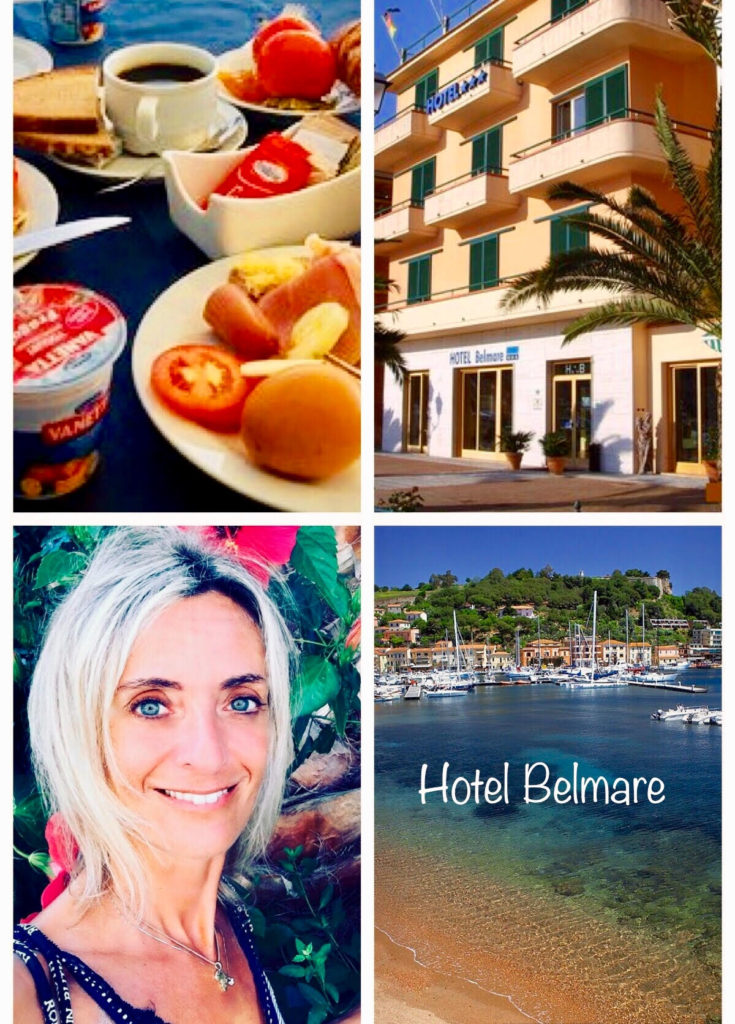
2nd Day. The “Arrighi Winery” in Elba island
My morning breakfast “Belmare Hotel” in Porto Azzurro was an abudant buffet with fresh bread, marmalade and an hot black coffe espresso . I set outside on the terrace looking out to see the first light of the day. Meantime, the sea-gulls were playing with the wind, while the fishermen where spreading their nets.
I was embraced by a warm and Mediterranean atmosphere. Soon after , as the heat was closing in on me, I took a refreshing dip in a small cove near Porto Azzurro city center. Nothing better than this! It set me up perfectly for the upcoming wonder of my your in Elba, that is my visit to “Arrighi Winery”
“Arrighi Winery”, in the heart of Porto Azzurro
At about eleven o’ clock Antonio collected me from my hotel to visit his estate in “Piano al Monte”,. Thi is an area in the eastern hills of Porto Azzurro, within the “Tuscan Archipelago National Park” . We arrived at his winery after only a few minutes drive. Then Antonio and I rode on a Quad , going around his amphitheatre of grapevines and his trekking wine paths in “Piano al Monte”.
While we rode he talked about his tremendous existence! From what he said it’s clear that Antonio is very fond of his family and of his farmhouse, whose secret ingredients are passion, tradition, and innovation. With a production of about 40,000 bottles per year, Antonio‘s property extends over 12 hectares, of which 7 are vineyards with 300 olive trees.
After this wine trip, I went into the office of Antonio , writing down all that was useful for a better understanding of the wine production in Elba.
Elba , the terroir and the goal of Antonio Arrighi in wine production
If asked what Elba‘ s flagship wine is , we would probably answer Aleatico, or Ansonica. Of course, these grapes expresses the cultural roots and spirit of the island! In particular the goal of Antonio is not only to produce wine from these local grapes, but also to experiment with new ones. Those grapes, which are best suited to the Elba with a proper terroir , which is unique in the world.
In brief, Antonio pointed out that viticulture has been always florid in Elba for this particular terroir, that is the result of of the geological past of the Elba itself ! Elba was infact the largest remaining portion of land that once connected the Italian peninsula to Corsica.
That’ why the Tuscan island boasts a wide variety of fertile terrains. Basically Elba is made from iron and clay, and different landscapes with high mountains, valleys, and small coastal plains. A third of the surface area is above 200m, and the highest point, which is “Monte Capanne” (1019 meters above sea level).
Thus all of these pedoclimatic characteristics of Elba together with sea, sun and a mild climate, are fundamental for an high quality of its wine production. Surely , Elba is full of wineries and vineyards , which occupy different terrains from distinct geological formations. Because of these varied soils, Elban wines flourish with unique organoleptic characteristics.
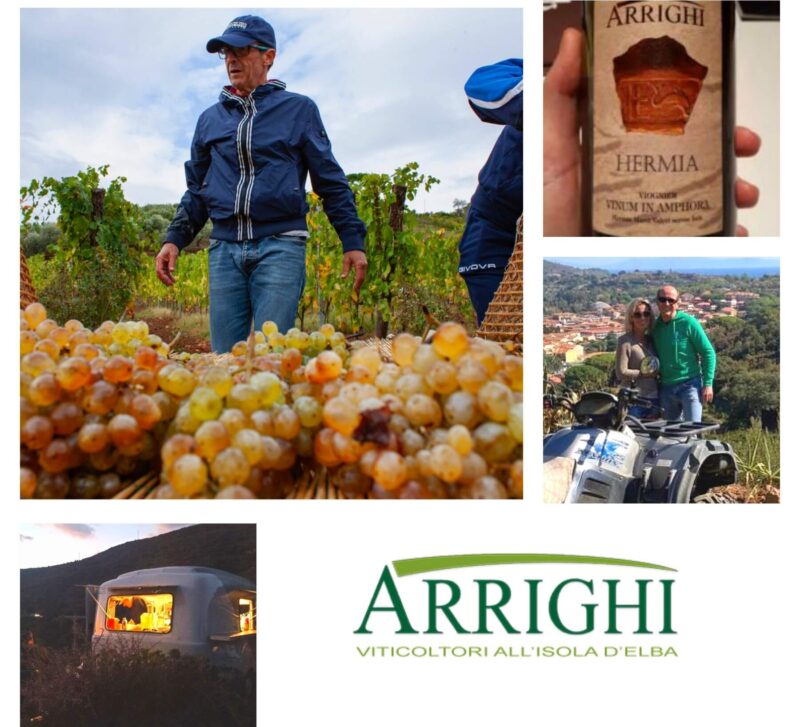
“Arrighi winery”, two lines of wine production
Antonio reminded me that the origin of Elban viticulture was very old. This sector together with farming, fishing and iron and granite mining activities made up a significant portion of the economy , before tourism’s environmental and social affected the island.
The best quality of Antonio is creativity. He has the imagination to create in his mind a wine . Later he knows how to realise it in his winery. That’s because as Antonio says: ” winemaking is an art as well as a science, and having the ability to think outside the box and to improvise, when needed, are critical skills to be successful”.
Antonio is intuitive and perceptive enough to be able to understand Elba ‘s terroir and coax out its maximum potential. In this way, his wines reflect their origin and have their own personality. It has led him to develop two lines of wine production:
- The first line is based on the historic grape varieties of the island: Procanico (or Trebbiano), Ansonica (or Inzolia), Biancone, Riminese (or Vernaccia) for the white wines. Sangioveto, Tintiglia and the famous Aleatico for the red wines;
- The second line is based on the international grape varieties: Chardonnay, Incrocio Manzoni (Riesling and Pinot Blanc) and Viognier for the white wines. Syrah, Sagrantino and Tempranillo for the red wines.
What about wine tradition in Elba island?
Specifically, the importance of traditional knowledge in wine can be recognised for example in the the vinification in terracotta amphorae. As you’ll see in my post, Antonio displayed this old technique thatwith scientific rigor in his winery!
What about wine production today in Elba island?
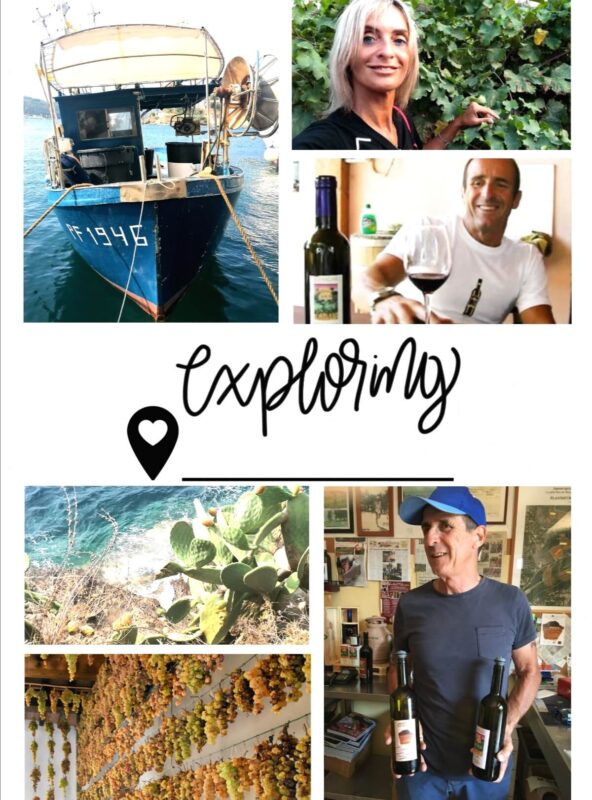
The wines of “Arrighi Winery”, Elba
Listening to Antonio tall about his passion for Elba makes you wish to return again and again. I absolutely believe it , especially after tasting his labels in his winery with other wine lovers , all there aiming to grab Elba‘s spirit.
Besides Antonio‘s Aleatico vinegar “Ace di Ale” , his liquors “Limoncino” / “Arancino”, and his olive oil, here are my top 9 reasons for your next trip to Porto Azzurro :
- “Ilagiù Elba White D.O.C.”: It’s a mineral and fruity wine, which is made from 80% Procanico and a small amount of Biancone, Ansonica ;
- “Era Ora White IGT”: It’s a round and dry white wine with good acidity, which is made from Chardonnay and Incrocio Manzoni. Part of this wine has been aged in French oak barrique ;
- “Mattanto D.O.C.”: It’s made from 100% Ansonica (5000 plants per hectare ), and its flavour is dry, full and soft. It’s one of the most important label ;
- “V.I.P. Viognier White I.G.T. “: It’s a mineral and sophisticated white wine, which is made from 100% Viognier (6000 plants per hectare) . It remains at least 3 months in bottles for aging;
- “Valerius White I.G.T. “: It’s a soft white wine made from 100% Ansonica (6000 plants per hectare) with vinifcation in terracotta amphora (220 litres). It’s a very harmonious and persistent white wine with a good sapidity;
- “Isola in Rosa Rosé I.G.T. “: It’s a delicate rosé wine made from 100% Syrah (5000 plants per hectare). It brings to mind thoughts of Southern France with its pale coral hue. It’s aged 4 months in bottles;
- “Centopercento Elba Red D.O.C.”: It’s a full-body and fruity red wine made from 80 % Sangiovese and 20% Syrah (5000 plants per hectare);
- “Siloso Elba Aleatico Passito Red D.O.C.G. “: This wonderful raisin wine is made exclusively from 100 % Aleatico grapes . It has an intense ruby red colour. Its cherries aroma is the perfect pairing with sweets like the traditional Elban “schiaccia ubriaca”. It is a round and soft Christmas cake with the peculiarity of having red wine in the dough.
Unquestionably, my favourite products of this wonderful wine tasting from 2018 have been:
- “Tresse Anfora Red I.G.T.” : It’s a spicy and rich wine made from Sangioveto, Syrah, and Sagrantino. It’s the only wine from 2016, being vinified before in oak barrique. In 2018 thanks to the help of Laura Zuddas, who is the oenologist of the farmhouse, Antonio vinified the “Tresse” in terracotta amphorae, like the old Romans did! Antonio likes this kind of vinification, above all because terracotta is a simple and natural material comparable to wood. This method allows wines to breath without releasing any flavours to them. Basically , “Tresse” is a full-bodied wine that passionately embraces the palate preserving refinement, revealing itself chromatically with the illusion of a berry syrup;
- “Hermia Vinum in Amphora White I.G.T.”: It’s a elegant white wine made from 100% Viognier . It is very light due to a natural winemaking with terracotta amphorae . Thesere are made by “Artenova” from Impruneta (800 litres ). Its name recalls “Hermia”, an ancient slave, who was a cellar master for a Roman villa founded in “San Giovanni”, an village near Portoferrario.
Why is Antonio Arrighi a talented winemaker in Elba island? Passion and hard work is the right answer !
Sometimes you just start to wonder if you actually want to recommend a place. Because it will become even more popular and lose some of its authentic charms! However, “Arrighi Winery” is just too good not no be mentioned! The wines were as fabulous as their reasonable prices.
Besides providing a very high standard wine tasting, Antonio went on answering all the question of other guests attending that incredible wine event in his winery. Each of us was very happy with Antonio . He is such a gorgeous person . You can just feel the passion that he puts behind his work. Please, make yourself comfortable, and relax ! That’s not all about Antonio ! Follow me for a litte bit more!
“Nesos”: how the Greek made the sustainable underwater wine 2500 years ago
“Nesos” is an attempt to revive, on the island of Elba, the mysterious wine of Chios, famous in ancient times for its intense flavour and its secret recipe!
At this point the question arises, whether Antonio is crazy or not! Certainly, he is a visionary pioneer with professional skills. Thereupon, wine experts and universities decided to collaborate with him to support this challenge, that combines oenology and archaeology .
To begin with, in 2018 Antonio organized the “Elba Aleatico Day “ , a wine and oil exhibition supported by the “AIS of Elba” and by the “Ministry of Agriculture”. In this conference he met Attilio Scienza, a well-known agronomist at Milano University, which was his main partner in launching this extraordinary experiment.
Why don’t to resurrect a marine wine said to be favoured by Julius Caesar?
Primarily, this experiment witness the interest of Antonio in recreating a kind of sustainable wine as ancient vine growers did in Chios! Reviving the underwater wine was a big discovery for this crazy winemaker from Elba for two important reasons.
First, because of saltwater! It worked as a natural antioxidant and disinfectant agent! Subsequently, there is no more need for sulphites in making wines! Second, saltwater get rid of the waxy white surface bloom, and allows the fruit to dry quickly in the sun. This preserves more aromas, being so tasteful unlike anything else.
The adventure of producing “Nesos” in the blue sea of Porto Azzurro
First of all, Antonio and his team reproduced this ancient process using Ansonica grape variety, also known as Inzolia. They are which are similar to the old grapes used for making the famous wine in Chios. After the harvesting, he pulled down Ansonica grapes into the sea water of Porto Azzurro down to approximately 7 meters for 5 days.
After that, Antonio took Ansonica grapes held in Sardinian wicker baskets out of the sea water. In the end, he dehydrated these grapes , drying them on mats. Finally, Antonio vinified the grapes in terracotta amphorae, which found its place once again in winemaking after many centuries a with minimal interventions!
What kind of wine is “Nesos”?
Previewing this “old greek wine” at “Arrighi Winery”, before it’s improved year after year and released to retail, makes me feel real special ! “Nesos” is a strong and sapid wine , gold in colour. The nose is round. It is played on particular hints of yellow apple fruit followed by peat and seaweed aromas, as well as broom flowers typical of Elba. It is delicate and refreshing, with a savoury olive finish.
“Vinum Insulae”, a video trailer by Stefano Muti about “Nesos”
Given that, there is also a documentary film called “Vinum Insulae” shot by Stefano Muti , which immortalizes Antonio’s undertaking . This is a 15 minutes trailer, which was awarded at the Marsille’s Film Festival “Aenovideo 2019” .
My wine and life experience at “Arrighi Winery” was unforgettable. It’s really unbelievable how a strong passion for the territory and wine drove Antonio to make his dreams come true. He must try new approaches and think out of the proverbial box!
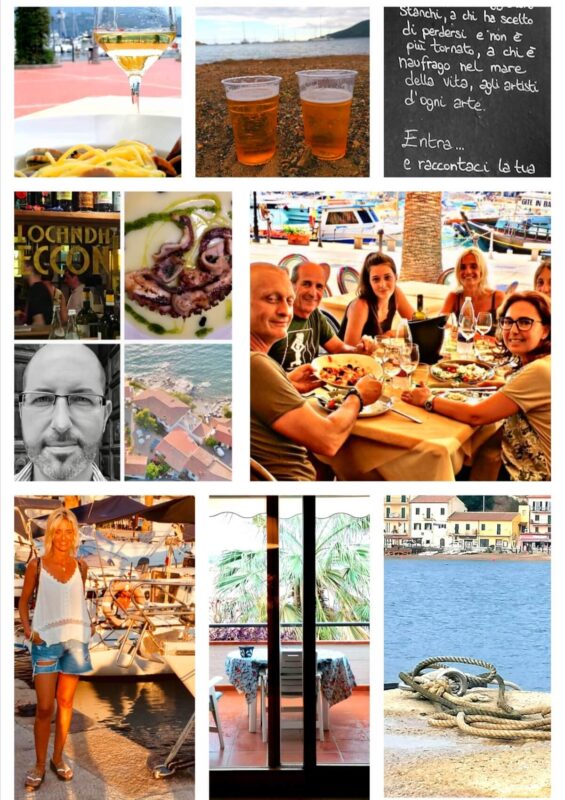
Before saying Bye Bye to the magic Elba!
After the superb wine tasting, I wallowed in a turquoise sea at “Barbarossa Beach” on the way back to my hotel on the last day of my holiday. “Barbarossa” is one of the most beautiful and popular beaches of the of Porto Azzurro. You can get there on foot from Porto Azzurro harbour thanks to a path that runs along the coast, passing under the prison’s walls.
Walking along this beautiful scenic path you can arrive at the “Barbarossa Beach” in about 15 minutes. “Barbarossa Beach” has a sandy shore mixed with multicoloured pebbles ranging from red to grey and brown. It has both free access and beach clubs, offering rental services of umbrellas, sunbeds and paddle boats.
“Locanda Cecconi”, where to eat in Elba island
It was pleasant to stay at the “Barbarossa Beach” till my stomach rambled! I went away to have a shower in my hotel dreaming for my last dinner in the Island. I booked at “Locanda Cecconi” as Antonio suggested! Federico with his mother run this cosy and friendly restaurant in the heart of Porto Azzurro.
I had the best grilled octopus of my life, which was served on a creamy potato and on home-made bread. My friend Walter Tripicchio joined me for the dessert time. He entertained me finely with his anecdotes about Elba and about his delightful “Scoglio Bianco Hotel”, which is situated in the appealing bay of Viticcio.
Thanks Antonio!
Antonio never ceases to amaze! When he doesn’t work at his vineyards, he jogs early at 5 o’ clock in the morning. In this way , he proves his fidelity to have been an excellent triathlon runner and traveller in the past.
Due to lack of time, cannot travel so much anymore. Furthermore, being ambassador of his island, Antonio does not have a moment of rest, participating in the most important trade fairs, or attending university lectures halls as a teacher . I have fallen in love with Elba . I cannot wait to return! Go to Elba if you want a good life, and let me know if you need my help and tips !
If you like my post, please subscribe to the socials of www.WeLoveitaly.eu :





